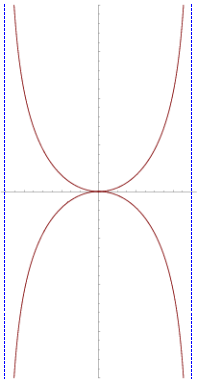The kappa curve has two vertical asymptotes In geometry , the kappa curve or Gutschoven's curve is a two-dimensional algebraic curve resembling the Greek letter ϰ (kappa) . The kappa curve was first studied by Gérard van Gutschoven around 1662. In the history of mathematics , it is remembered as one of the first examples of Isaac Barrow 's application of rudimentary calculus methods to determine the tangent of a curve. Isaac Newton and Johann Bernoulli continued the studies of this curve subsequently.
Using the Cartesian coordinate system it can be expressed as
x
2
(
x
2
+
y
2
)
=
a
2
y
2
{\displaystyle x^{2}\left(x^{2}+y^{2}\right)=a^{2}y^{2}}
or, using parametric equations ,
x
=
a
sin
t
,
y
=
a
sin
t
tan
t
.
{\displaystyle {\begin{aligned}x&=a\sin t,\\y&=a\sin t\tan t.\end{aligned}}}
In polar coordinates its equation is even simpler:
r
=
a
tan
θ
.
{\displaystyle r=a\tan \theta .}
It has two vertical asymptotes at x = ±a , shown as dashed blue lines in the figure at right.
The kappa curve's curvature :
κ
(
θ
)
=
8
(
3
−
sin
2
θ
)
sin
4
θ
a
(
sin
2
(
2
θ
)
+
4
)
3
2
.
{\displaystyle \kappa (\theta )={\frac {8\left(3-\sin ^{2}\theta \right)\sin ^{4}\theta }{a\left(\sin ^{2}(2\theta )+4\right)^{\frac {3}{2}}}}.}
Tangential angle:
ϕ
(
θ
)
=
−
arctan
(
1
2
sin
(
2
θ
)
)
.
{\displaystyle \phi (\theta )=-\arctan \left({\tfrac {1}{2}}\sin(2\theta )\right).}
Tangents via infinitesimals
The tangent lines of the kappa curve can also be determined geometrically using differentials and the elementary rules of infinitesimal arithmetic. Suppose x and y are variables, while a is taken to be a constant. From the definition of the kappa curve,
x
2
(
x
2
+
y
2
)
−
a
2
y
2
=
0
{\displaystyle x^{2}\left(x^{2}+y^{2}\right)-a^{2}y^{2}=0}
Now, an infinitesimal change in our location must also change the value of the left hand side, so
d
(
x
2
(
x
2
+
y
2
)
−
a
2
y
2
)
=
0
{\displaystyle d\left(x^{2}\left(x^{2}+y^{2}\right)-a^{2}y^{2}\right)=0}
Distributing the differential and applying appropriate rules ,
d
(
x
2
(
x
2
+
y
2
)
)
−
d
(
a
2
y
2
)
=
0
(
2
x
d
x
)
(
x
2
+
y
2
)
+
x
2
(
2
x
d
x
+
2
y
d
y
)
−
a
2
2
y
d
y
=
0
(
4
x
3
+
2
x
y
2
)
d
x
+
(
2
y
x
2
−
2
a
2
y
)
d
y
=
0
x
(
2
x
2
+
y
2
)
d
x
+
y
(
x
2
−
a
2
)
d
y
=
0
x
(
2
x
2
+
y
2
)
y
(
a
2
−
x
2
)
=
d
y
d
x
{\displaystyle {\begin{aligned}d\left(x^{2}\left(x^{2}+y^{2}\right)\right)-d\left(a^{2}y^{2}\right)&=0\\(2x\,dx)\left(x^{2}+y^{2}\right)+x^{2}(2x\,dx+2y\,dy)-a^{2}2y\,dy&=0\\\left(4x^{3}+2xy^{2}\right)dx+\left(2yx^{2}-2a^{2}y\right)dy&=0\\x\left(2x^{2}+y^{2}\right)dx+y\left(x^{2}-a^{2}\right)dy&=0\\{\frac {x\left(2x^{2}+y^{2}\right)}{y\left(a^{2}-x^{2}\right)}}&={\frac {dy}{dx}}\end{aligned}}}
Derivative
If we use the modern concept of a functional relationship y (x ) and apply implicit differentiation , the slope of a tangent line to the kappa curve at a point (x ,y ) is:
2
x
(
x
2
+
y
2
)
+
x
2
(
2
x
+
2
y
d
y
d
x
)
=
2
a
2
y
d
y
d
x
2
x
3
+
2
x
y
2
+
2
x
3
=
2
a
2
y
d
y
d
x
−
2
x
2
y
d
y
d
x
4
x
3
+
2
x
y
2
=
(
2
a
2
y
−
2
x
2
y
)
d
y
d
x
2
x
3
+
x
y
2
a
2
y
−
x
2
y
=
d
y
d
x
{\displaystyle {\begin{aligned}2x\left(x^{2}+y^{2}\right)+x^{2}\left(2x+2y{\frac {dy}{dx}}\right)&=2a^{2}y{\frac {dy}{dx}}\\2x^{3}+2xy^{2}+2x^{3}&=2a^{2}y{\frac {dy}{dx}}-2x^{2}y{\frac {dy}{dx}}\\4x^{3}+2xy^{2}&=\left(2a^{2}y-2x^{2}y\right){\frac {dy}{dx}}\\{\frac {2x^{3}+xy^{2}}{a^{2}y-x^{2}y}}&={\frac {dy}{dx}}\end{aligned}}}
References
External links
Category :
Text is available under the Creative Commons Attribution-ShareAlike License. Additional terms may apply.
**DISCLAIMER** We are not affiliated with Wikipedia, and Cloudflare.
The information presented on this site is for general informational purposes only and does not constitute medical advice.
You should always have a personal consultation with a healthcare professional before making changes to your diet, medication, or exercise routine.
AI helps with the correspondence in our chat.
We participate in an affiliate program. If you buy something through a link, we may earn a commission 💕
↑









